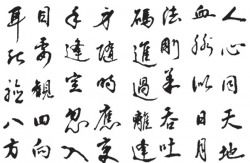karatemom3
Yellow Belt
I'm curious, were the eight key concepts of martial arts written by Grandmaster Whang Kee? Do other martial arts use them?
Follow along with the video below to see how to install our site as a web app on your home screen.
Note: This feature may not be available in some browsers.
I'm guessing yes.I'm curious, were the eight key concepts of martial arts written by Grandmaster Whang Kee? Do other martial arts use them?
The eight key concepts of Soo Bahk Do Moo Duk Kwan and their literal translation:
1. Yong Gi - Courage (Brave / Energy)
2. Chung Shin Tong Il - Concentration (Clean, Clear / God / Govern / One)
3. In Neh - Endurance (Endure / Patience)
4. Chung Jik - Honesty (Right / Straight)
5. Kyum Son - Humility (Humble / Humble)
6. Him Cho Chung - Control of Power (Power / Manage / Right)
7. Shin Chook - Tension and Relaxation (Relaxation, Expand / Tension, Contract)
8. Wan Gup - Speed Control (Slow / Fast)

well, my system, Tibetan White Crane, has four:
Chuan - Ruthless cruelty
Siam - Dodge or Evade
Chuin - Attack, Penetrate, Charge aggressively
Git - Intercept
so I guess ours are a little different.
I like this one very much.
Tibetan White Crane must not be a defensive art!
yeah, the idea behind it is that fighting isn't for play. If the bad guy is really intent on going after you, then you give him everything you've got. If it isn't worth giving all you've got, then there probably isn't a reason to fight at all. When you make the decision to unleash hell, there had better be good reason for it.
It is often obscured in American schools, but in the original copy of the Tang Soo Do manual, there were, in addition to the key concepts, ten 'Articles of Faith'. One translates roughly as: 'Kill in justice.'
This is the crux of the defining purpose of the traditional arts as they were intended. Somewhere along the line the guts of the arts were obscured while a less violent more excepted means of getting into shape, sports oriented, turn the other cheek attitude emerged. In doing this the dojo of "old" became obsolete and antiquated, and rightly so because of the onset of "karate is for everybody. I am not putting down either way because it is up to each and every person to choose for themselves what is right or wrong for them. The "Precepts/Concepts" written within this thread elude to this, as we read between the lines. :asian:yeah, the idea behind it is that fighting isn't for play. If the bad guy is really intent on going after you, then you give him everything you've got. If it isn't worth giving all you've got, then there probably isn't a reason to fight at all. When you make the decision to unleash hell, there had better be good reason for it.
The Articles of Faith are an interesting transplant from Korean culture. They seem to change in minor ways depending on the TSD school.
...
8. Know the difference between good and evil. (I've also seen this written as Kill only in Justice and Honor)
...
Flying Crane, Your point is well taken. I've had a very limited view of martial arts and am learning a lot here. I don't think it would go over well to teach 4 and 5 year old's in my school Chuan-Ruthless cruelty but we could have a more aggressive self defensive program for adults.
The Articles of Faith are an interesting transplant from Korean culture. They seem to change in minor ways depending on the TSD school.
1. Be loyal to your country.
2. Be obedient to your parents.
3. Be loving between husband and wife.
4. Be cooperative between brothers.
5. Be faithful between friends.
6. Be respectful to your elders.
7. Be faithful between teacher and student.
8. Know the difference between good and evil. (I've also seen this written as Kill only in Justice and Honor)
9. Never retreat in battle.
10. Always finish what you start.
|
